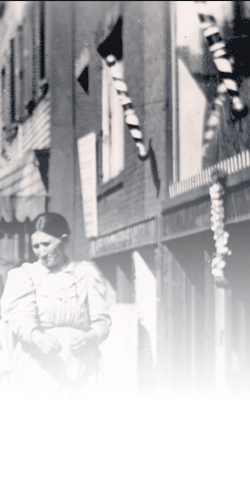| Every city directory entry is part of a story, reflections of change
can be noted, and histories can be traced. Combined with the images,
maps, and geospatial layers included with this project, the directories
offer the ability to contextualize in time and place a single history
or the history of millions. Often these histories cross without connections,
other times they converge and overlap.
A Widow's Decline
Nelllie Aarestrup is just one of the more than one million people,
businesses, schools, societies, laborers, marble polishers, physicians,
hotels, and churches recorded in the directories offered as part of
Boston Streets. We "meet" Nellie first in her absence as
only her husband Alf, a marriner, is listed in the 1870
directory, however by 1872 Capt. Aarestrup has passed away, and
Nellie is listed for the first time in the directories offered as
part of the Boston Streets collection. In 1872,
Nellie is a widow, which we see is considered to be her "occupation,"
and not a honorary title, as indicated by the organization and typography
used by directory compilers. A few short years later, we see that
Nellie has gone through another "life change," which one
may assume was not for the better. In the 1875
directory she no longer owns her home, but boards at a different
address (indicators of home ownership, residence and boarding are
used in the directories), and has a profession of "cigars,"
perhaps rolling them in her boarding rooms. Gone are the listing of
her previous state of widowhood or her husband's name and homestead.
Clerks
Another story tells us something about where people lived and
what they did. In 1845 numerous clerks were employed in the city's
financial and business center. They seldom lived near these places
and had to commute from various places around the city. Mapping
the clerks in 1845, shows a large concentration (darker symbols)
of clerks working downtown, while living in the surrounding neighborhoods.
Changing Neighborhoods
Still other stories are about the constants of place and the changing
people who inhabit those places. In 1845, Robert Frazer, a tailor,
lived at 23 Prince Street and worked around the corner on Hanover
Street. Fifty years later, in 1905, after an influx of Italian immigrants
turned what was by now known as the North End into a "Little
Italy" 23 Prince street is now home to Michele Fabrizio. Fabrizio
coincidentally is a tailor as well. Twenty years later, 23 Prince
Street remains a part of a vibrant Italian neighborhood and is now
home to Gaetano Marotto and Antonio Giovino both listed as laborers.
You can find Prince Street on the map and see a list of the people
who lived there over time and the jobs they held using Cowpaths.
Murder of the Century
Other, more famous stories also weave their way through the directories.
In one of the most sensational crimes of the era, the wealthy Dr.
George Parkman was murdered in 1849 on the grounds of the Harvard
Medical College, now the Massachusetts General Hospital. Parkman was
killed by a friend and colleague, John Webster over a debt. In 1845,
the Parkmans are listed as living on Beacon Hill in the family home
at 33 Beacon Street. The 1855 directory mutely lists his widow, Mrs.
George F. Parkman, and their son, George F. Parkman, Jr still living
the family home.
Cowpaths
shows us not only the location of the home and who lived there
in 1855, but also that there are photographs from approximately the
same era, one of them taken by Josiah Hawes.
Pioneering Photographers
Josiah Hawes and his partner, Albert Southworth were the most celebrated
of the early photographers in America. They set up shop in Boston
in 1843, just three years after the first daguerreotype was exhibited
in the United States. At first specializing in portraits, Hawes also
begain to photograph urban scenes after Southworth headed to California
to seek gold in 1849, You can map some
of Hawes' photos in Cowpaths. Hawes lived in the city until his
death in 1901 and can be found in each of the directories from 1845
through 1885.
These are just some of the millions stories you can find in the records
of the city.
|


